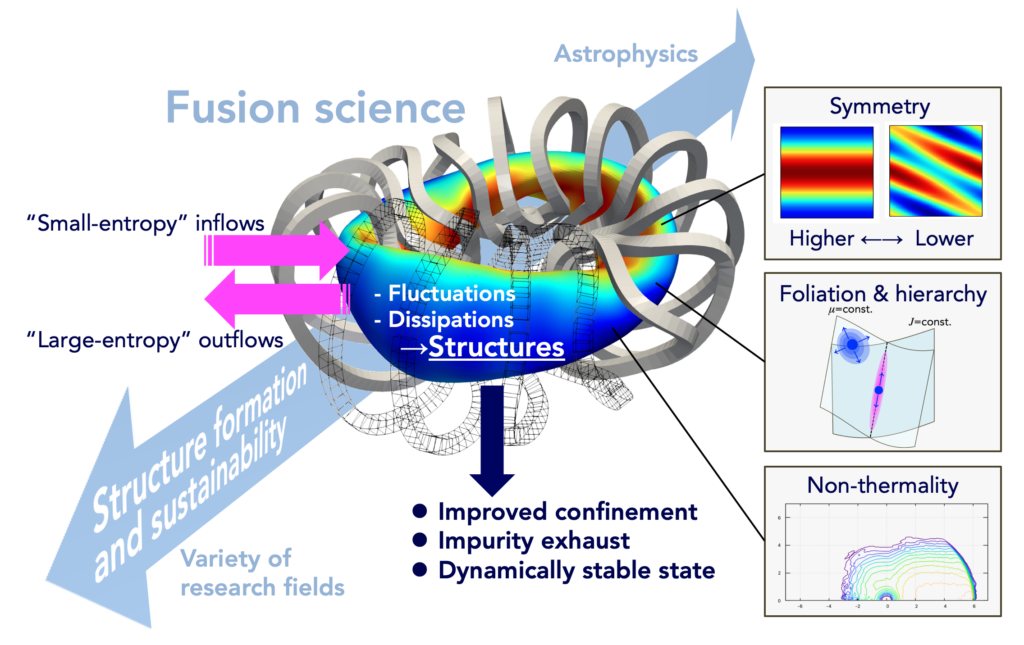Latest News
News List-
Research Summary
One of the core goals of magnetic fusion research is to establish an efficient method to sustain the confinement of high-temperature plasma, which is an open system put in the middle of the flows. Confinement of plasma using magnetic field is not as simple as confinement by electrostatic or gravitational fields, as even an “equilibrium distribution” of plasma in magnetic field is not fully understood. Although the role of magnetic geometry in the dynamics of a charged particle and collisional transport has been largely elucidated and applied to designs of advanced devices, that in the formation of global structure of plasma including confinement improvement is still an open question.
In this Unit, these issues of fusion research are reformulated as the problem of the physics of structure formation and its sustainability as shown in Fig.1. The central question is how the non-trivial, inhomogeneous distributions emerge and are sustained in the middle of the flow of energy, momentum, and matter. The spontaneous formation and sustainability of inhomogeneity, or “small-entropy structures”, are a common problem of open systems. We pursue the basic principle that governs the plausibility of state of fluctuating complex systems by utilizing the flexibility inherent to fusion plasmas, such as symmetry and hierarchy in dynamics brought by magnetic field.
Under the cooperation of experimentalists and theoreticians, the researches will be conducted in multiple perspectives originating in fusion science; the phase-space physics of non-thermal particles, invariant measure in the presence of magnetic field, symmetry of the system, multi-species transport, extended MHD theory and simulations, and relation between structure formation and entropy production rate, etc. The important fusion-oriented goal of this Unit is to clarify the general role of magnetic field in the structure formation of plasma, and to establish new guidelines for optimization of magnetic configuration. The optimization research will cover not only the magnetic configuration but also the device and reactor system.

Fig.1: Inter-disciplinary perspective of structure formation of fusion plasma in this Unit.
Member
*:Unit Leader
-
Assist. Prof. FUJITA, Keiji
-
Prof. ICHIGUCHI, KatsujiFields MHD theory, Simulation, MHD stability
-
Project Prof. IDO, TakeshiAffiliate Kyushu University
-
Prof. ISOBE, MitsutakaFields High-energy particle physics, Neutron physics, Quasi-symmetric configuration physics
-
Assist. Prof. ITO, AtsushiFields MHD theory, Mathematical Physics, Two fluid effect
-
Assist. Prof. KAWAMOTO, YasukoFields Impurity ion diagnostics, High-energy particle diagnostics
-
Project Assoc. Prof. KOGA, MayukoAffiliate University of Hyogo
-
COE Researcher LIAO Longyong
-
Assist. Prof. NISHIMURA, ShinFields High-energy and thermal particle neoclassical phenomena, Quasi-symmetric configuration
-
Assist. Prof. NUGA, HideoFields Fokker-Planck analysis, Fast ion analysis, Integrated code
-
Assoc. Prof. OGAWA, KunihiroFields Energetic particle physics, Neutron gamma-ray diagnostics
-
Prof. OSAKABE, MasakiFields High-energy particle physics, Neutron physics, Beam physics
-
Assoc. Prof. SATAKE, Shinsuke (Chairperson)Fields Neoclassical transport theory and simulation, Configuration optimization
-
Assist. Prof. SHIMIZU, AkihiroFields Fluctuation diagnostics, Quasi-symmetric configuration physics, Configuration optimization
-
Assoc. Prof. TAKAHASHI, Hiromi (Unit Leader)Fields Plasma heating, Cofinement improvement, High performance plasma
-
Assoc. Prof. YAMAGUCHI, HiroyukiFields Integrated simulation, Heating simulation, Configuration optimization
External Member
-
IDO, TakeshiAffiliate Kyushu University, Prof.
-
FUJITA, TakaakiAffiliate Nagoya University, Prof.
-
HIMURA, HaruhikoAffiliate Kyoto Inst. Tech., Prof.
-
INAGAKI, ShigeruAffiliate Kyoto University, Prof.
-
MORISHITA, YuyaAffiliate Kyoto University, Assist. Prof.
-
MURAKAMI, SadayoshiAffiliate Kyoto University, Prof.
-
NAGASAKI, KazunobuAffiliate Kyoto University, Prof.
-
SHINOHARA, KoujiAffiliate Tokyo University, Prof.
Publications
Contact
Email:sfs

